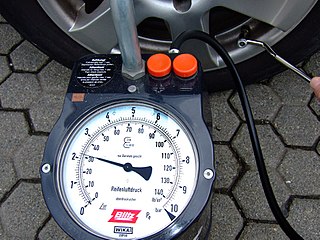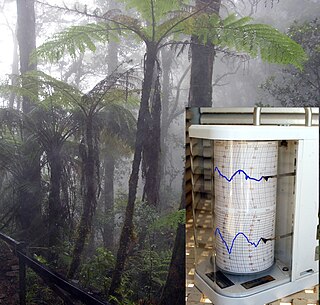
Pressure is the force applied perpendicular to the surface of an object per unit area over which that force is distributed. Gauge pressure is the pressure relative to the ambient pressure.
Standard temperature and pressure (STP) are various standard sets of conditions for experimental measurements to be established to allow comparisons to be made between different sets of data. The most used standards are those of the International Union of Pure and Applied Chemistry (IUPAC) and the National Institute of Standards and Technology (NIST), although these are not universally accepted standards. Other organizations have established a variety of alternative definitions for their standard reference conditions.
Atmospheric pressure, also known as air pressure or barometric pressure, is the pressure within the atmosphere of Earth. The standard atmosphere is a unit of pressure defined as 101,325 Pa (1,013.25 hPa), which is equivalent to 1,013.25 millibars, 760 mm Hg, 29.9212 inches Hg, or 14.696 psi. The atm unit is roughly equivalent to the mean sea-level atmospheric pressure on Earth; that is, the Earth's atmospheric pressure at sea level is approximately 1 atm.

The pascal is the unit of pressure in the International System of Units (SI). It is also used to quantify internal pressure, stress, Young's modulus, and ultimate tensile strength. The unit, named after Blaise Pascal, is a SI coherent derived unit defined as one newton per square metre (N/m2). It is also equivalent to 10 barye in the CGS system. Common multiple units of the pascal are the hectopascal, which is equal to one millibar, and the kilopascal, which is equal to one centibar.
In chemistry and related fields, the molar volume, symbol Vm, or of a substance is the ratio of the volume occupied by a substance to the amount of substance, usually given at a given temperature and pressure. It is equal to the molar mass (M) divided by the mass density (ρ):
The cubic foot is an imperial and US customary (non-metric) unit of volume, used in the United States and the United Kingdom. It is defined as the volume of a cube with sides of one foot in length. Its volume is 28.3168 L.
Actual cubic feet per minute (ACFM) is a unit of volumetric flow. It is commonly used by manufacturers of blowers and compressors. This is the actual gas delivery with reference to inlet conditions, whereas cubic foot per minute (CFM) is an unqualified term and should only be used in general and never accepted as a specific definition without explanation. Since the volumetric capacity refers to the volume of air or other gas at the inlet to the unit, it is often referred to as "inlet cubic feet per minute" (ICFM).
In thermodynamics, the specific volume of a substance is an intrinsic property of the substance, defined as the ratio of the substance's volume to its mass. It is the reciprocal of density ρ (rho) and it is related to the molar volume and molar mass:

Cold inflation pressure is the inflation pressure of tires before a car is driven and the tires (tyres) warmed up. Recommended cold inflation pressure is displayed on the owner's manual and on the placard attached to the vehicle door edge, pillar, glovebox door or fuel filler flap. Most passenger cars are recommended to have a tire pressure of 30 to 35 pounds per square inch when not warmed by driving. 40% of passenger cars have at least one tire under-inflated by 6 psi or more. Drivers are encouraged to make sure their tires are adequately inflated, as under inflated tires can greatly reduce fuel economy, increase emissions, cause increased wear on the edges of the tread surface, and can lead to overheating and premature failure of the tire. Excessive pressure, on the other hand, will lead to impact-breaks, decreased braking performance, and cause increased wear on the center part of the tread surface.
Standard cubic feet per minute (SCFM) is the molar flow rate of a gas expressed as a volumetric flow at a "standardized" temperature and pressure thus representing a fixed number of moles of gas regardless of composition and actual flow conditions. It is related to the mass flow rate of the gas by a multiplicative constant which depends only on the molecular weight of the gas. There are different standard conditions for temperature and pressure, so care is taken when choosing a particular standard value. Worldwide, the "standard" condition for pressure is variously defined as an absolute pressure of 101,325 pascals, 1.0 bar, 14.73 psia, or 14.696 psia and the "standard" temperature is variously defined as 68 °F, 60 °F, 0 °C, 15 °C, 20 °C, or 25 °C. The relative humidity is also included in some definitions of standard conditions.
Various governmental agencies involved with environmental protection and with occupational safety and health have promulgated regulations limiting the allowable concentrations of gaseous pollutants in the ambient air or in emissions to the ambient air. Such regulations involve a number of different expressions of concentration. Some express the concentrations as ppmv and some express the concentrations as mg/m3, while others require adjusting or correcting the concentrations to reference conditions of moisture content, oxygen content or carbon dioxide content. This article presents a set of useful conversions and formulas for air dispersion modeling of atmospheric pollutants and for complying with the various regulations as to how to express the concentrations obtained by such modeling.
The flow coefficient of a device is a relative measure of its efficiency at allowing fluid flow. It describes the relationship between the pressure drop across an orifice valve or other assembly and the corresponding flow rate.

The saturation vapor density (SVD) is the maximum density of water vapor in air at a given temperature. The concept is related to saturation vapor pressure (SVP). It can be used to calculate exact quantity of water vapor in the air from a relative humidity Given an RH percentage, the density of water in the air is given by RH × SVD = Actual Vapor Density. Alternatively, RH can be found by RH = Actual Vapor Density / SVD. As relative humidity is a dimensionless quantity, vapor density can be stated in units of grams or kilograms per cubic meter.
Base conditions, also known as standard conditions, consist of a specified absolute pressure and temperature. To ensure accuracy, it is important to refer to base conditions when measuring the volume of a sample of liquid or gas. This applies to both static measurement and flow measurement.
Several units of volume are used in petroleum engineering.

In thermodynamics, the volume of a system is an important extensive parameter for describing its thermodynamic state. The specific volume, an intensive property, is the system's volume per unit of mass. Volume is a function of state and is interdependent with other thermodynamic properties such as pressure and temperature. For example, volume is related to the pressure and temperature of an ideal gas by the ideal gas law.

The pound per square inch or, more accurately, pound-force per square inch, is a unit of measurement of pressure or of stress based on avoirdupois units. It is the pressure resulting from a force with magnitude of one pound-force applied to an area of one square inch. In SI units, 1 psi is approximately equal to 6895 Pa.

Air pollutant concentrations, as measured or as calculated by air pollution dispersion modeling, must often be converted or corrected to be expressed as required by the regulations issued by various governmental agencies. Regulations that define and limit the concentration of pollutants in the ambient air or in gaseous emissions to the ambient air are issued by various national and state environmental protection and occupational health and safety agencies.
The standard liter per minute is a unit of mass flow rate of a gas at standard conditions for temperature and pressure (STP), which is most commonly practiced in the United States, whereas European practice revolves around the normal litre per minute (NLPM). Until 1982, STP was defined as a temperature of 273.15 K and an absolute pressure of 101.325 kPa (1 atm). Since 1982, STP is defined as a temperature of 273.15 K and an absolute pressure of 100 kPa (1 bar).

The metresea water (msw) is a metric unit of pressure used in underwater diving. It is defined as one tenth of a bar.






